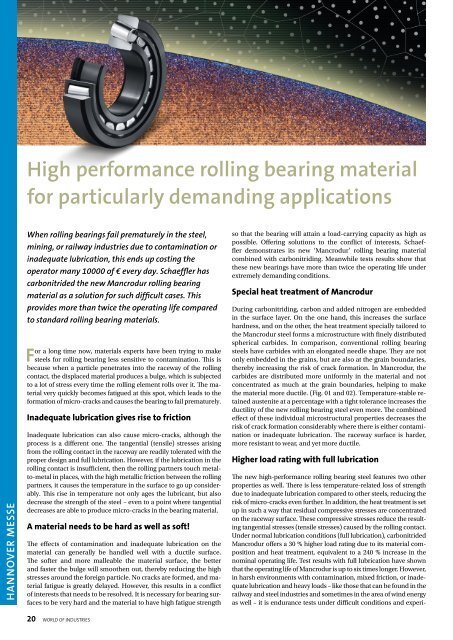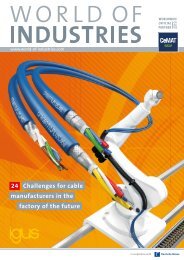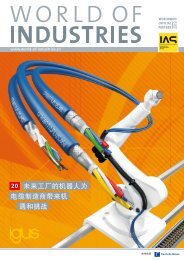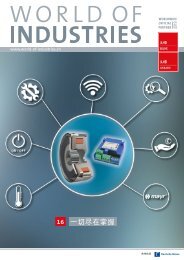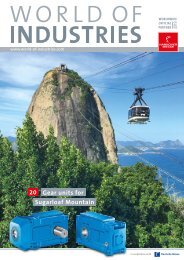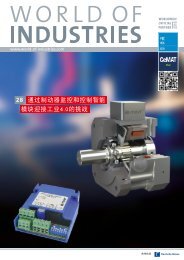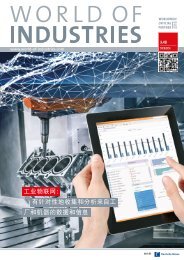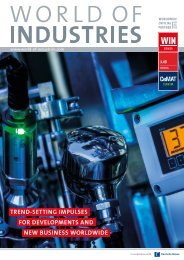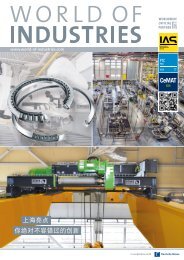world of industries 3/2017 (EN)
world of industries 3/2017 (EN)
world of industries 3/2017 (EN)
- TAGS
- world
- industries
Create successful ePaper yourself
Turn your PDF publications into a flip-book with our unique Google optimized e-Paper software.
High performance rolling bearing material<br />
for particularly demanding applications<br />
HANNOVER MESSE<br />
When rolling bearings fail prematurely in the steel,<br />
mining, or railway <strong>industries</strong> due to contamination or<br />
inadequate lubrication, this ends up costing the<br />
operator many 10000 <strong>of</strong> € every day. Schaeffler has<br />
carbonitrided the new Mancrodur rolling bearing<br />
material as a solution for such difficult cases. This<br />
provides more than twice the operating life compared<br />
to standard rolling bearing materials.<br />
For a long time now, materials experts have been trying to make<br />
steels for rolling bearing less sensitive to contamination. This is<br />
because when a particle penetrates into the raceway <strong>of</strong> the rolling<br />
contact, the displaced material produces a bulge, which is subjected<br />
to a lot <strong>of</strong> stress every time the rolling element rolls over it. The material<br />
very quickly becomes fatigued at this spot, which leads to the<br />
formation <strong>of</strong> micro-cracks and causes the bearing to fail prematurely.<br />
Inadequate lubrication gives rise to friction<br />
Inadequate lubrication can also cause micro-cracks, although the<br />
process is a different one. The tangential (tensile) stresses arising<br />
from the rolling contact in the raceway are readily tolerated with the<br />
proper design and full lubrication. However, if the lubrication in the<br />
rolling contact is insufficient, then the rolling partners touch metalto-metal<br />
in places, with the high metallic friction between the rolling<br />
partners, it causes the temperature in the surface to go up considerably.<br />
This rise in temperature not only ages the lubricant, but also<br />
decrease the strength <strong>of</strong> the steel – even to a point where tangential<br />
decreases are able to produce micro-cracks in the bearing material.<br />
A material needs to be hard as well as s<strong>of</strong>t!<br />
The effects <strong>of</strong> contamination and inadequate lubrication on the<br />
material can generally be handled well with a ductile surface.<br />
The s<strong>of</strong>ter and more malleable the material surface, the better<br />
and faster the bulge will smoothen out, thereby reducing the high<br />
stresses around the foreign particle. No cracks are formed, and material<br />
fatigue is greatly delayed. However, this results in a conflict<br />
<strong>of</strong> interests that needs to be resolved. It is necessary for bearing surfaces<br />
to be very hard and the material to have high fatigue strength<br />
so that the bearing will attain a load-carrying capacity as high as<br />
possible. Offering solutions to the conflict <strong>of</strong> interests, Schaeffler<br />
demonstrates its new ‘Mancrodur’ rolling bearing material<br />
combined with carbonitriding. Meanwhile tests results show that<br />
these new bearings have more than twice the operating life under<br />
extremely demanding conditions.<br />
Special heat treatment <strong>of</strong> Mancrodur<br />
During carbonitriding, carbon and added nitrogen are embedded<br />
in the surface layer. On the one hand, this increases the surface<br />
hardness, and on the other, the heat treatment specially tailored to<br />
the Mancrodur steel forms a microstructure with finely distributed<br />
spherical carbides. In comparison, conventional rolling bearing<br />
steels have carbides with an elongated needle shape. They are not<br />
only embedded in the grains, but are also at the grain boundaries,<br />
thereby increasing the risk <strong>of</strong> crack formation. In Mancrodur, the<br />
carbides are distributed more uniformly in the material and not<br />
concentrated as much at the grain boundaries, helping to make<br />
the material more ductile. (Fig. 01 and 02). Temperature-stable retained<br />
austenite at a percentage with a tight tolerance increases the<br />
ductility <strong>of</strong> the new rolling bearing steel even more. The combined<br />
effect <strong>of</strong> these individual microstructural properties decreases the<br />
risk <strong>of</strong> crack formation considerably where there is either contamination<br />
or inadequate lubrication. The raceway surface is harder,<br />
more resistant to wear, and yet more ductile.<br />
Higher load rating with full lubrication<br />
The new high-performance rolling bearing steel features two other<br />
properties as well. There is less temperature-related loss <strong>of</strong> strength<br />
due to inadequate lubrication compared to other steels, reducing the<br />
risk <strong>of</strong> micro-cracks even further. In addition, the heat treatment is set<br />
up in such a way that residual compressive stresses are concentrated<br />
on the raceway surface. These compressive stresses reduce the resulting<br />
tangential stresses (tensile stresses) caused by the rolling contact.<br />
Under normal lubrication conditions (full lubrication), carbonitrided<br />
Mancrodur <strong>of</strong>fers a 30 % higher load rating due to its material composition<br />
and heat treatment, equivalent to a 240 % increase in the<br />
nominal operating life. Test results with full lubrication have shown<br />
that the operating life <strong>of</strong> Mancrodur is up to six times longer. However,<br />
in harsh environments with contamination, mixed friction, or inadequate<br />
lubrication and heavy loads – like those that can be found in the<br />
railway and steel <strong>industries</strong> and sometimes in the area <strong>of</strong> wind energy<br />
as well – it is endurance tests under difficult conditions and experi-<br />
20 WORLD OF INDUSTRIES


